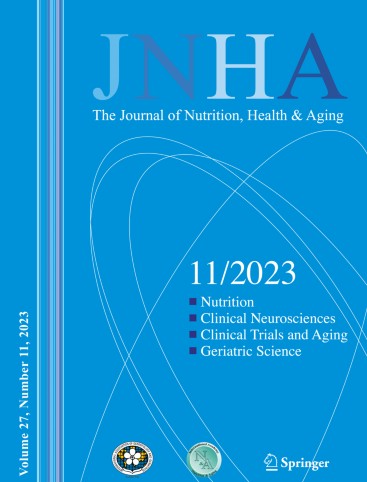精神分裂症患者虚弱的速度加快
IF 4
3区 医学
Q1 GERIATRICS & GERONTOLOGY
引用次数: 0
摘要
精神分裂症与死亡率和身体合并症的风险增加有关,表明受影响个体可能加速衰弱过程。本研究旨在使用基于实验室标记的虚弱指数(FI-Lab)来测试精神分裂症与虚弱之间的关联。方法选取600例精神分裂症患者和518例健康对照,年龄在20 ~ 69岁之间。使用FI-Lab评估虚弱程度,包括常规实验室标记物、体重指数和血压测量。将精神分裂症患者和健康对照者的FI-Lab进行比较,并按年龄组和性别分层。此外,稳健定义为FI-Lab≤0.12,预虚弱定义为0.12 - 0.25,虚弱定义为>;0.25。采用多元线性回归分析检验精神分裂症与FI-Lab的相关性。采用多项逻辑回归检验精神分裂症与虚弱状态之间的关系。采用Spearman相关分析评估精神分裂症患者PANSS评分与FI-Lab的关系。结果各年龄组精神分裂症患者的FI-Lab均明显高于健康对照组,表明精神分裂症患者的衰弱速度加快。在调整后的模型中,精神分裂症与FI-Lab显著相关(β = 0.044, p = 0.004)。在调整后的模型中,与健康状态相比,精神分裂症与虚弱前状态(OR = 2.26, 95% CI = 1.40−3.68,p = 0.001)和虚弱状态(OR = 10.33, 95% CI = 5.65−19.93,p = 0.007)均显著相关。此外,FI-Lab和PANSS评分呈正相关,表明精神分裂症症状越严重,虚弱程度越高。结论:这些发现表明精神分裂症会增加身体虚弱的风险。FI-Lab提供了虚弱的定量测量。这强调了将虚弱因素纳入精神分裂症治疗和管理的重要性。本文章由计算机程序翻译,如有差异,请以英文原文为准。
Accelerated pace of frailty in patients with schizophrenia
Background
Schizophrenia is associated with an increased risk of mortality and physical comorbidities, indicating a potentially accelerated frailty process in affected individuals. This study aimed to test association between schizophrenia and frailty using the frailty index based on laboratory markers (FI-Lab).
Methods
A total of 600 patients with schizophrenia and 518 healthy controls, aged between 20 and 69 years were included in the present study. Frailty was assessed using the FI-Lab, incorporating routine laboratory markers, body mass index, and blood pressure measurements. FI-Lab for patients with schizophrenia and healthy controls was compared, with stratification by age group and sex. In addition, robust was defined as FI-Lab ≤ 0.12, pre-frail as 0.12–0.25, and frail as >0.25. Multiple linear regression analysis was used to test the association between schizophrenia and FI-Lab. Multinomial logistic regression was used to test the association between schizophrenia and frailty status. Spearman correlation analysis was performed to assess the relationship between the Positive and Negative Syndrome Scale (PANSS) scores and FI-Lab in schizophrenia patients.
Results
Schizophrenia patients exhibited significantly higher FI-Lab than healthy controls across all age groups, indicating accelerated pace of frailty in schizophrenia patients. Schizophrenia was significantly associated with FI-Lab (β = 0.044, p = 0.004) in the adjusted model. Schizophrenia was significantly associated with both pre-frail status (OR = 2.26, 95% CI = 1.40−3.68, p = 0.001) and frail status (OR = 10.33, 95% CI = 5.65−19.93, p = 0.007) compared to robust status in the adjusted model. Additionally, a positive correlation between FI-Lab and PANSS scores suggests that more severe schizophrenia symptoms correlate with higher degree of frailty.
Conclusion
These findings suggest that schizophrenia contributes to an increased risk of frailty. The FI-Lab provides a quantitative measure of frailty. This underscores the importance of integrating frailty considerations into the treatment and management of schizophrenia.
求助全文
通过发布文献求助,成功后即可免费获取论文全文。
去求助
来源期刊
CiteScore
7.80
自引率
3.40%
发文量
136
审稿时长
4-8 weeks
期刊介绍:
There is increasing scientific and clinical interest in the interactions of nutrition and health as part of the aging process. This interest is due to the important role that nutrition plays throughout the life span. This role affects the growth and development of the body during childhood, affects the risk of acute and chronic diseases, the maintenance of physiological processes and the biological process of aging. A major aim of "The Journal of Nutrition, Health & Aging" is to contribute to the improvement of knowledge regarding the relationships between nutrition and the aging process from birth to old age.

 求助内容:
求助内容: 应助结果提醒方式:
应助结果提醒方式:


